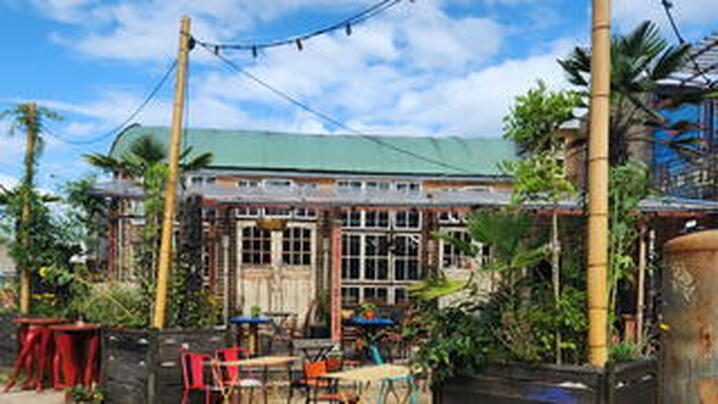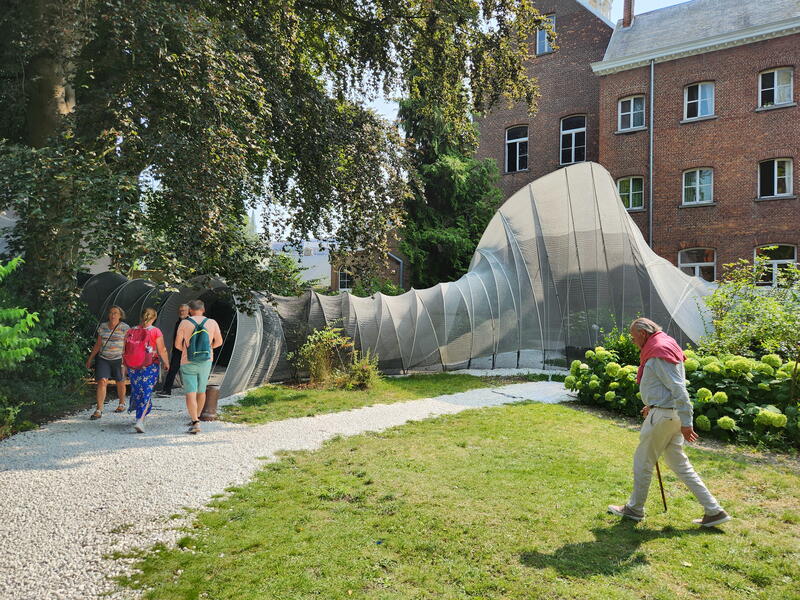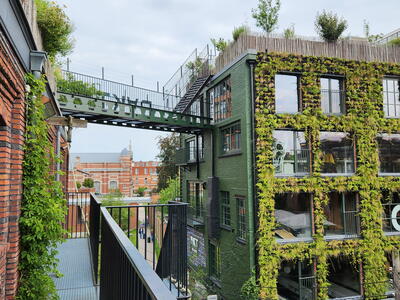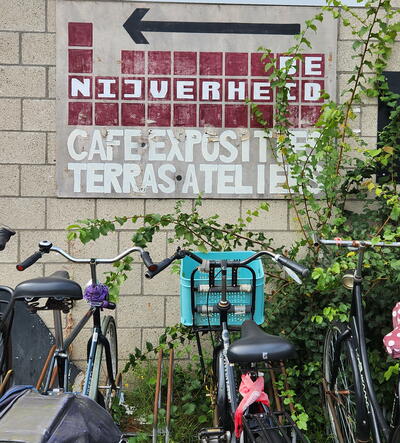
Through the generous support of the Tranter-Leong Fellowship and ICMA global community, I was able to connect with municipal staff across Belgium and the Netherlands. I explored cities such as Bruges, Antwerp, Ghent, and Utrecht to discuss arts and culture programming, climate initiatives, and housing subsidies. It was not only the beautiful canals that connected these cities, but a shared focus on intertwining the arts in daily life, creating mixed-use spaces that offer opportunities for creatives/residents and much more. Each city navigates a complex balance of maintaining the heritage of a European metropolis while striving to push forward innovative and sustainable programming. I am incredibly grateful for the opportunity provided by the Tranter-Leong Fellowship, and I hope to share my findings with my community and the wider ICMA network. I encourage young professionals to apply for the fellowship to broaden their perspective and learn from others on a global scale.
Individual Visits and Collective Lessons
Bruges: I travelled to Bruges, Belgium, interested in their arts and culture, climate initiatives, and potentially some excellent chocolate. After a plane ride, train ride and car ride, I began by exploring the current Triennale exhibition, which offers tourists a way to explore the city off the beaten path. The Triennale "Spaces of Possibility" is a curated exhibition that occurs every three years that asks artists to answer a question or challenge posed by the city. This year focused on activating spaces outside of the Bruges city center, and artists answered the question "How can a UNESCO World Heritage Site, where preservation is central, deal with concepts such as change and sustainability, and how can contemporary art and architecture create a new framework for these processes?" In an effort to address this question, artists worked within the community to install pieces that connected the history of the city to its transformative potential. Learn more about the Triennale.

While in Bruges, I had the opportunity to chat with policymakers regarding Bruges’ climate action plan Bruges Narr Morgen. This plan includes steps for residents, businesses, and governments to become more energy efficient. The main takeaway from their strategy was the accessibility of energy saving adaptations available to the community. Residents looking to make their homes more energy efficient could travel to a centrally located municipal space to receive guidance and information on energy-saving alternatives that could transform their properties.
Antwerp: Just over an hour train ride away, I entered the historic port city of Antwerp, Belgium. Though major topics of conversation focused on housing and multiuse spaces, I was able to explore much of Antwerp and its surrounding communities with their daily bike passes. For five euros, I was able to rent a bike and return it to conveniently located racks around the city. It was a great way to see a different side of Antwerp, especially as a tourist!
During my visit I was able to speak with municipal housing staff who showed me their current housing exhibit in the city center. The project explored the creation and development of Antwerp and garnered feedback on future planning considerations. The exhibit was conveniently located and contained an enjoyable feedback mechanism involving chalkboards. The accessibility of the exhibit and central location was a wonderful way to encourage community engagement.

In the evenings, I visited a mixed-use space called PAKT, located in a previous industrial site, nestled within a neighborhood outside the city center. PAKT has a rooftop garden with its own water collection system, garden plots available for rent, and multiple commercial spaces below. There is a daycare on the first floor along with a gym, cafés, and restaurants and located next to a mixed social housing complex. The space was welcoming, inviting, and clearly an excellent example of mixed-use space from a previous industrial factory.
Ghent: Hopping on the train once more, I visited Ghent, Belgium, a “medieval city” complete with castles, canals, and amazing connections. Ghent has a large university population that offers unique cultural and housing challenges. EUniverCities, a European network of mid-size cities and universities that work toward actionable solutions, is a potential solution to these challenges. There are four clusters that focus on a variety of concerns: historical preservation, student life, world/international presence, and urban challenges.
Another exciting visit was to De Krook, a knowledge center located in the heart of Ghent. The center operates as a meeting space for the university and the city residents. Allowing access to resources such as computer labs, research equipment, makerspaces, and theater equipment, De Krook offers a space that benefits the wider community. There are university and city events hosted in De Krook and many community engagement activities that take place here as well. The design and creation of the space is a mutual effort from the university and city, showcasing a collaboration that will continue to grow.

Utrecht: A final train ride landed me in Utrecht, Netherlands, with the aim to discuss mobility hubs and multi-use spaces. During my visit, I was able to meet with multiple municipal staff to discuss a variety of upcoming goals in Utrecht. A point of interest was potential mobility hubs, including shared car options in the future. Currently, there are multiple locations within the city where residents can rent a bike, run errands, and return the bike to a central location, one of which is within walking distance of Utrecht Central train station. This aligns with a future goal of creating an Utrecht with little to no cars. Mobility hubs would expand availability for those who need to rent a bike or a shared car. Many buildings currently maintain bike storage to encourage residents to commute via bikes.
While exploring Utrecht, I visited an Arts and Culture center called Nijverheid, which is a multi-use space hosted in a previous industrial site. This space maintains a café, alongside multiple artists workshops and commercial spaces for artists to conduct business. In addition, the space holds musical performances and contains multiple galleries with a rotating showcase of work. This space is not only a collaborative design with reused materials, but a collaborative environment where the community can benefit from the creativity of its residents.
Common Threads, Takeaways, and Recommendations
Across all four cities I visited, I found several notable through-lines that I think we should keep close at hand in our work in local government. Here are five key takeaways:
Incorporating holistic approaches in urban design and potential placemaking strategies.
These approaches include sustainable practices and arts considerations. Many departments work closely together to produce urban designs that embrace key aspects of placemaking, which create livable and sustainable communities.
Arts are intertwined with culture. Art = Culture = Heritage = Quality of life.
There is an understanding that arts and culture are a cornerstone for an increased quality of life. Discussions in the United States on arts and culture initiatives are often associated with a reduction in budgets. In contrast, our global partners tend to consider arts and culture a key aspect in urban planning.
Maximizing multiuse spaces within cities.
All four cities I visited contained some version of a mixed-use facility. These spaces often activate and revitalize industrial sites that may be passed over by visitors. Supporting mixed-use spaces with community engagement strategies creates a deepened sense of belonging and encourages resident retention. Not only do these designs offer a multifunctional commercial space, but they also serve as centers for community activities.
Create accessible and simple infrastructure.
I do not own a bike; yet in my two weeks abroad, I was able to navigate easy bike rental apps and explore neighborhoods I may not have seen otherwise. The common denominator was ease of access throughout the entire process. Convenience and ease-of-use are often what make the difference between an effective resident program and an ineffective one. By planning urban designs with ease-of-use in mind, we can increase the success of these programs.
Global partnership and comradery: We’re all in the same boat!
There are many differences in governance approaches between the United States and our global counterparts; however, we are more alike than we are different. Whether it be climate change or housing crises, we are moving toward solutions on a global scale. In times so uncertain, we are certainly in this together.
A Once in a Lifetime Experience
I would like to thank all the staff that assisted in planning this trip, and my borough manager, for their support. I hope to adopt these ideas and apply them to not only to State College but my future communities as well. This was a once in a lifetime experience for me both professionally and personally. The staff I met abroad were incredibly helpful and willing to share any resources available, and the community members were quick to assist when Dutch signs confounded me.
Are you interested in participating in a professional global experience like this? Visit the ICMA Tranter-Leong Fellowship page for more information on this fellowship opportunity and to stay updated on the next application cycle.
New, Reduced Membership Dues
A new, reduced dues rate is available for CAOs/ACAOs, along with additional discounts for those in smaller communities, has been implemented. Learn more and be sure to join or renew today!
